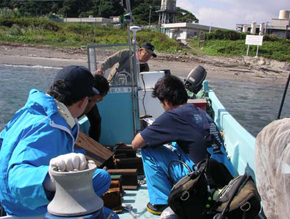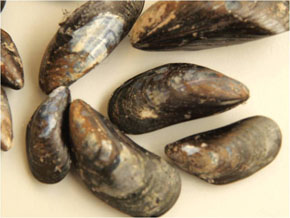Natural environment of coastal area is upon influence of various physical factors such as tide and current conditions. How these physical variation affects organisms living in coastal area? We are researching on larval dispersion of abalone and production structure of mussels by collecting physical data and mathematical simulation.
1. Larval Dispersion of Large Abalones
Large abalones are one of the most expensive fishery resources in Japan. Three species (disk abalone Haliotis discus discus, siebold's abalone H. gigantea and giant abalone H. madaka) inhabit in warm-current area, and one species (ezo abalone
Mathematical simulation of abalone larval dispersion was operated for assessment of warm-current area inhabiting abalone sanctuary, location at east of Sagami bay as an example of large scale bay. Large-scale and small scale spawning simulation showed existence of long distance (dispersion to offshore and transfered to coastal areas) and short distance (slowly dispersed to offshore) dispersion patterns. Transfer succession rate in the settlement period was compared in the sanctuary and 1km off to north, west and south as imaginary larval source. The highest succession was marked at the sanctuary (27-75%), thus the validity of the current sanctuary is proved.
On the other hand, DNA marker demonstrated that few juveniles are from adult abalones, even though 90% of adults from stockings. Thus, we examined larval dispersion in and out of the bay and verify natural and stocking adult abalones as larvae sources. Summer and fall simulation showed supply of larval abalones to the sanctuary is mainly from natural adults (60-70%), not from stocking adults. In other words, larva born in the sanctuary disperse to outside area and inflow of larva from outside composite juveniles in the sanctuary. Besides, larvae remaining rate in the bay is at least one order higher compared to that of the sanctuary. Thus, expansion of the sanctuary to the whole bay would encourage the resource recovery.
Next, we focused on the area which faces to open ocean, Sanriku coastal area. Reconstructions of larval dispersal from abalone fishery area illuminated the connectivity of seven separated fishing grounds. Mathematical models indicated existence of two different type of larval dispersal in mid- and southern coastal fishery grounds:long distance dispersal of large-scale spawning, and short distance dispersal of small-scale spawning. Besides, recovery rates of larva to their natal ground is relatively high. However, current and location affects negatively to the return rate of larva, which leads to invalidity of stocking and conservation methods. North two fishery grounds would be suited for the sanctuary, showed by our mathematical models.
These researches suggested large abalones take different dispersal strategies based on their spawning scale - long distance dispersal at large-scale spawning, and short distance dispersal at small-scale spawning. Larval dispersal is in affects of current and topographical characteristics. Larva disperse to outside before settlement even in small bay. Our results indicated local conservation of abalone would not be effective for resource recovery, and importance of quantitative assessment of abalone larvae. These researches develops methods to reconstruct larval dispersal patterns of large abalones, and to validify the sanctuary assessments. We expect these researches would help for recovery of severely declined abalone resources.
 |
| Picture1. Set up of Mooring System for Coastal Physical Condition Observation |
2. Production Structure of Mussels
What kind of relationship exists between coastal biological productivity structure and physical fluctuation of marine environment? We targeted mussel (Mytilus edulis), which inhabits coastal areas of north Atlantic to see the influence of physical factors to thier production structure.
Mussels are important fishery resources (Picture 2), and catch and aquaculture of the species are consumed in Europe. The Menai strait of England, which is our research location, is knowns as a large mussel beds in vast tideland (Figure 1). They filter phytoplanktons and consume as food source. Current observation, chrolophyl observation and stable isotope analysis indicates that mussels in the Menai strait use planktonic diatoms flowing into the strait by tidal activity and benthic diatom rose by current. For next research step, we will focus on species conposition inside the strait based on time and location, and productivity of benthic diatom in the vast tideland.
 |
 |
| Picture 2. Mussel Mytilus edulis | Figure 1. Mussel Beds in the Menai Strait |
References
- 干川裕・原素之.(2008) エゾアワビ放流種苗の再生産への貢献.月刊海洋,40,(9),534-537.
- 三宅陽一.(2007) 三浦半島西岸における暖流系大型アワビ浮遊幼生の輸送.東京大学大学院農学生命科学研究科水圏生物科学専攻,修士論文.
- Miyake, Y., Kimura, S., Kawamura, T., Horii, T., Kurogi, H. and Kitagawa, T. (2009) Simulating larval dispersal processes for abalone using a coupled particle-tracking and hydrodynamic model: implications for refugium design. Marine Ecology Progress Series, 387, 205-222.
- Miyake, Y. (2010) Studies on larval dispersal processes of large abalone in relation to establishment of harvest refugia —保護区設定に係る大型アワビ類の幼生分散過程に関する研究—.博士論文,東京大学.
- Miyake, Y., Kimura, S., Kawamura, T., Kitagawa, T., Hara, M. and Hoshikawa, H. (2010) Estimating larval supply of Ezo abalone Haliotis discus hannai in a small bay using a coupled particle-tracking and hydrodynamic model: insights into the establishment of harvest refugia. Fisheries Science, 76, 561-570.
- 森岡裕詞.(2008) 英国メナイ海峡におけるヨーロッパイガイ(Mytilus edulis)の餌料環境に関する研究.東京大学大学院新領域創成科学研究科自然環境学専攻,修士論文.


